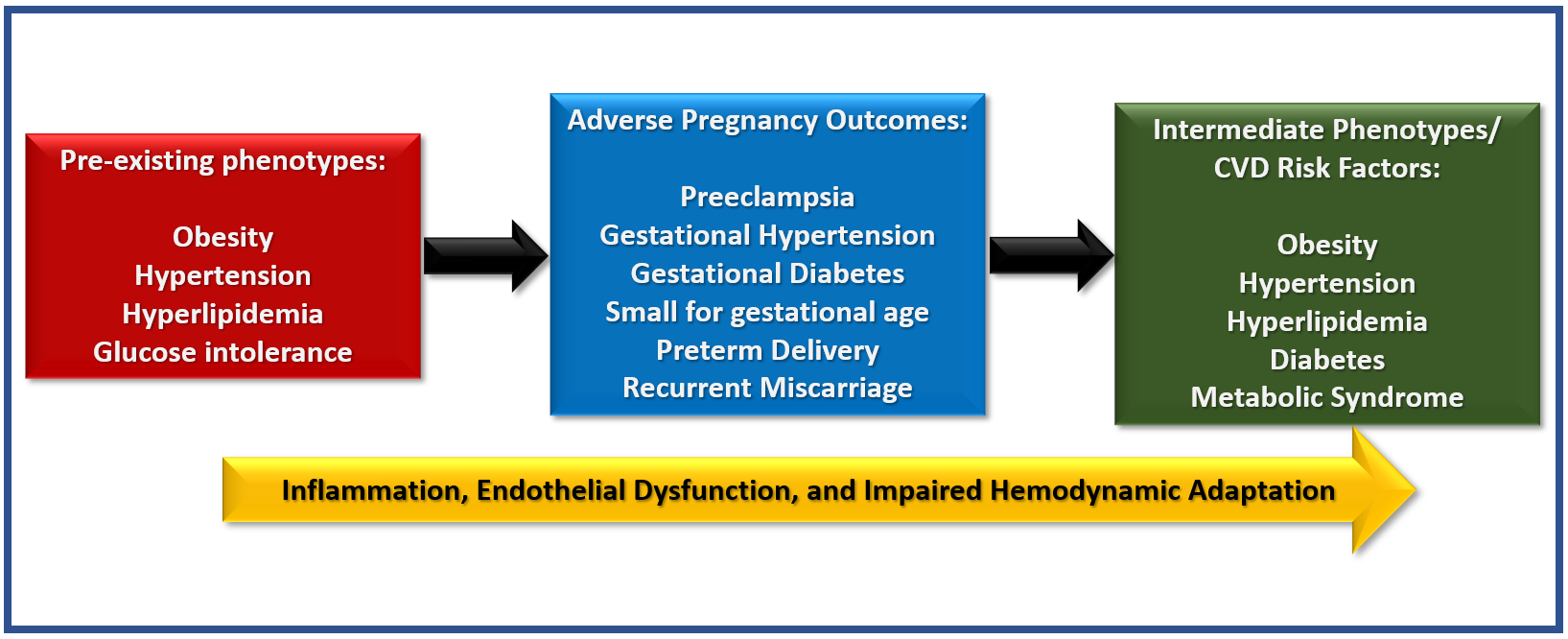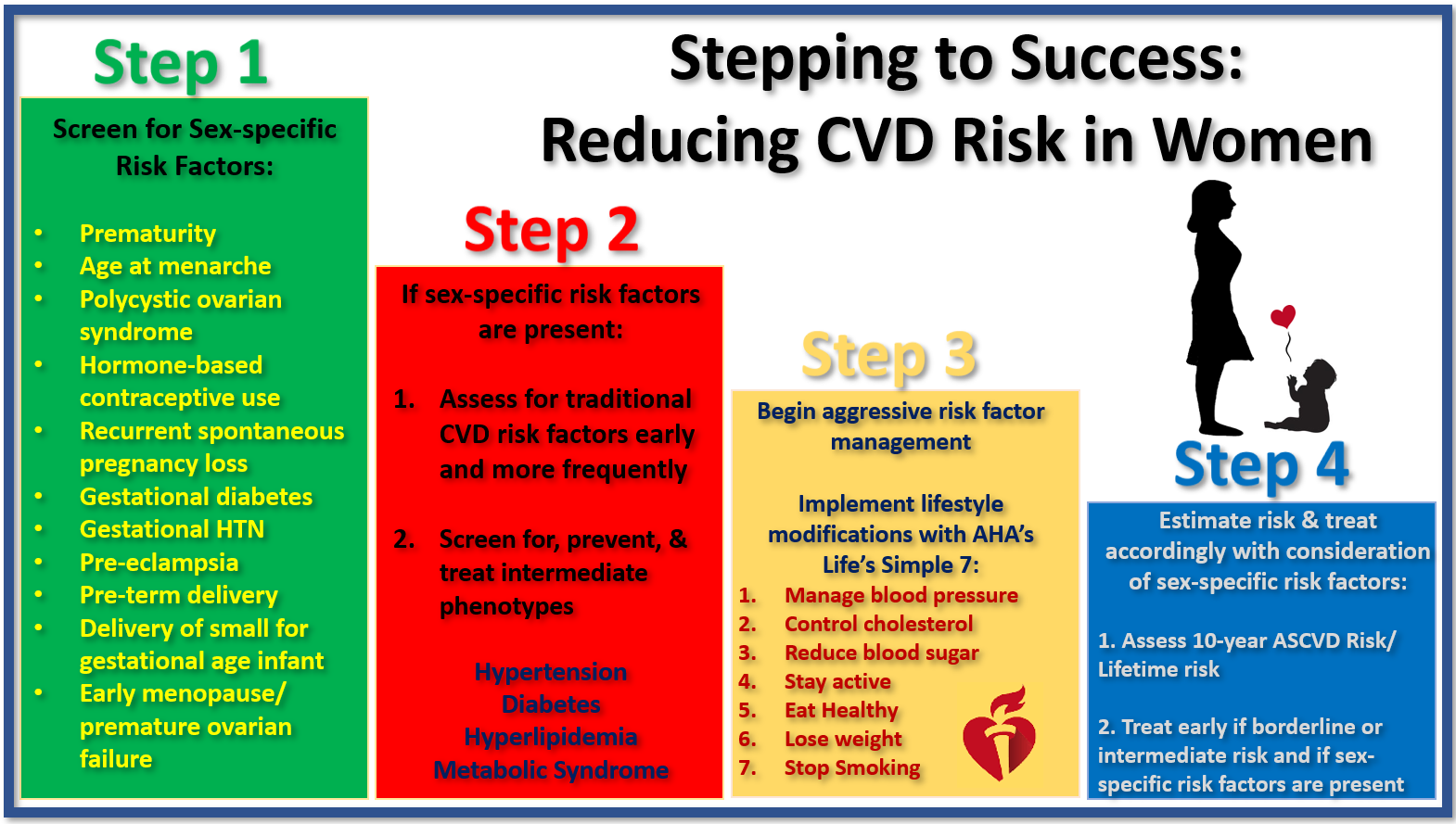Adverse Pregnancy Outcomes: A Window into Cardiovascular Disease Prevention
Introduction
Women are inadequately treated for cardiovascular disease (CVD) and its risk factors when compared to their male counterparts. Pregnancy and the postpartum period offer a unique window into a woman's cardiovascular risk profile along with an opportunity for intervention before the onset of CVD. The hemodynamics of pregnancy-increased cardiac output, expanded blood volume, reduced systemic vascular resistance, and decreased blood pressure are all instrumental changes that assist in accommodating a growing fetus. While the hemodynamic shifts of pregnancy are well tolerated by many, roughly 30% of women experience adverse pregnancy outcomes. These include preeclampsia (2-5% of births), gestational hypertension (3-14%), gestational diabetes (5%), pre-term delivery (6-12%), delivery of a small-for-gestational-age infant, and recurrent miscarriage. In this article, we discuss relevant studies that demonstrate the link between adverse pregnancy outcomes and future risk of CVD and highlight a means for optimizing preventive cardiovascular care in women.
Adverse Pregnancy Outcomes
Pre-existing clinical and subclinical phenotypes of glucose intolerance, obesity, hypertension, and hyperlipidemia contribute to endothelial dysfunction, inflammation, and impaired hemodynamic adaptation that can be unmasked during pregnancy as adverse pregnancy outcomes.1 Further adverse remodeling and accelerated vascular aging leads to the intermediate phenotypes of chronic hypertension, type 2 diabetes (T2D), hyperlipidemia, metabolic syndrome, and obesity, all of which portend an increased risk for CVD (Figure 1).
Figure 1: Pre-existing Phenotypes can Uncover Adverse Pregnancy Outcomes and Intermediate Phenotypes for Cardiovascular Disease
Adverse Pregnancy Outcomes provide an opportunity to identify at-risk women and implement measures to prevent or mitigate adverse cardiovascular outcomes.
Hypertensive disorders of pregnancy are made up of a constellation of conditions – gestational hypertension, pre-eclampsia, eclampsia, and hemolysis, elevated liver enzymes, and low platelet count, the prevalence of which is on the rise. More than 10% of women experience at least one instance of hypertensive disorder of pregnancy in their lifetime.2,3 Pre-eclampsia is associated with a 4-fold increased risk of incident heart failure and a 2-fold increased risk of coronary heart disease (CHD) and is recognized as a risk enhancing factor in the 2018 American Heart Association/ American College of Cardiology (AHA/ACC) Multi-society cholesterol guideline.4,5 Hypertensive disorders of pregnancy are associated with increased arterial stiffness and a greater prevalence of chronic hypertension, both of which are features of accelerated cardiovascular aging.6 Women with hypertensive disorders of pregnancy have a higher incidence of several cardiovascular conditions including coronary artery disease, heart failure, aortic stenosis, and mitral regurgitation, and should be screened for the development of such.6
Gestational diabetes: Placental production of hormones such as estrogen, cortisol, and human placental lactogen, are secreted to aid the development of a growing fetus. These hormones increase insulin resistance, and in roughly 5% of pregnancies, lead to the development of gestational diabetes. Gestational diabetes confers an 8-fold increased risk of developing T2D after pregnancy and is independently associated with an increased risk of CVD.7-9
Pre-term delivery occurs more often in women who are overweight, obese, or have lower high-density lipoprotein (HDL-C) levels.10,11 Preterm delivery is independently associated not only with increased CVD risk, but with intermediate phenotypes of chronic hypertension, T2D, and hypercholesterolemia, particularly within the first decade after the pregnancy.12-14
Small-for-gestational-age infants are <10th percentile for gestational age. Delivery of a small for gestational age infant is associated with future maternal risk for CVD that is related to severity and number of small-for-gestational-age deliveries.15 Women who deliver small-for-gestational-age infants have a higher prevalence of chronic hypertension and may be less likely to accommodate the hemodynamic changes of pregnancy.15,16
Recurrent miscarriage: Women with a history of two or more miscarriages have significantly greater odds for CHD.17,18 Maternal metabolic syndrome, polycystic ovarian syndrome, and endothelial dysfunction are all associated with an elevated risk for miscarriage and CVD suggesting shared risk factors that contribute to both conditions.
A Clinical Framework for the Management of Sex-specific Risk Factors
While association studies demonstrate the link between sex-specific risk factors and CVD, these factors have yet to be incorporated into traditional cardiovascular risk stratification models. There is an unmet need to deliver high-quality, preventive cardiovascular care to women with a history of sex-specific risk factors.19,20 Women should be monitored closely for these conditions during and after pregnancy, and if they occur, should expeditiously undergo comprehensive preventive screening and management. Our recent publication outlines sex-specific risk factors that increase a women's cardiovascular risk and distills the management of these patients into a 4-step algorithm (Figure 2):21
Figure 2: Steps to Success: Reducing Cardiovascular Disease Risk in Women
- Obtain a thorough obstetrical and gynecologic history for comprehensive cardiovascular risk stratification.
- Women with sex-risk factors should undergo early and frequent screening for traditional CVD risk factors in addition to screening for, prevention of, and treatment of related intermediate phenotypes (hypertension, diabetes, hyperlipidemia, and metabolic syndrome).
- Implement aggressive lifestyle modifications using the AHA's Life's simple 7: managing blood pressure, controlling cholesterol, reducing blood sugar, becoming and remaining active, healthy eating, weight loss, and smoking cessation.22,23
- Complete traditional cardiovascular risk assessment: lifetime risk in patients between the ages of 20-59 and the 10-year ASCVD risk for patients between the ages of 40 and 75. Early statin initiation or intensification should be considered in individuals at borderline or intermediate risk with the presence of these sex-specific risk factors.
Conclusion
Pregnancy and sex-specific risk factors provide a unique glimpse into a woman's cardiovascular health, giving us a ripe opportunity to screen and intervene early.24 The ability to transform cardiovascular care for women lies in our ability to use this abundantly available information to our advantage.
References
- Hauspurg A, Ying W, Hubel CA, Michos ED, Ouyang P. Adverse pregnancy outcomes and future maternal cardiovascular disease. Clin Cardiol 2018;41:239-46.
- Benton SJ, Leavey K, Grynspan D, Cox BJ, Bainbridge SA. The clinical heterogeneity of preeclampsia is related to both placental gene expression and placental histopathology. Am J Obstet Gyneco 2018;219:604.
- Ananth CV, Keyes KM, Wapner RJ. Pre-eclampsia rates in the United States, 1980-2010: age-period-cohort analysis. BMJ 2013;347:f6564.
- Wu P, Haththotuwa R, Kwok CS, et al. Preeclampsia and future cardiovascular health: a systematic review and meta-analysis. Circ Cardiovasc Qual Outcomes 2017;10:e003497.
- Grundy SM, Stone NJ, Bailey AL, et al. 2018 AHA/ACC/AACVPR/AAPA/ABC/ACPM/ADA/AGS/APhA/ASPC/NLA/PCNA guideline on the management of blood cholesterol. J Am Coll Cardiol 2019;73:3168-3209.
- Honigberg MC, Zekavat SM, Aragam K, et al. Long-term cardiovascular risk in women with hypertension during pregnancy. J Am Coll Cardiol 2019;74:2743-54.
- Bellamy L, Casas JP, Hingorani AD, Williams D. Type 2 diabetes mellitus after gestational diabetes: a systematic review and meta-analysis. Lancet 2009;373:1773-9.
- Kramer CK, Campbell S, Retnakaran R. Gestational diabetes and the risk of cardiovascular disease in women: a systematic review and meta-analysis. Diabetologia 2019;62:905-14.
- Fadl H, Magnuson A, Ostlund I, Montgomery S, Hanson U, Schwarcz E. Gestational diabetes mellitus and later cardiovascular disease: a Swedish population based case-control study. BJOG 2014;121:1530-6.
- Catov JM, Snyder GG, Bullen BL, Barinas-Mitchell EJM, Holzman C. Women with preterm birth have evidence of subclinical atherosclerosis a decade after delivery. J Womens Health (Larchmt) 2019;28:621-7.
- Kuklina EV, Shilkrut A. Spontaneous preterm labor and cardiovascular disease risk: one step closer to a better understanding. J Womens Health (Larchmt) 2012;21:619-20.
- Tanz LJ, Stuart JJ, Williams PL, et al. Preterm delivery and maternal cardiovascular disease in young and middle-aged adult women. Circulation 2017;135:578-89.
- Minissian MB, Kilpatrick S, Eastwood JA, et al. Association of spontaneous preterm delivery and future maternal cardiovascular disease. Circulation 2018;137:865-71.
- Tanz LJ, Stuart JJ, Williams PL, et al. Preterm delivery and maternal cardiovascular disease risk factors: the Nurses' Health Study II. J Womens Health (Larchmt) 2019;28:677-85.
- Ngo AD, Roberts CL, Chen JS, Figtree G. Delivery of a small-for-gestational-age infant and risk of maternal cardiovascular disease--a population-based record lnkage study. Heart Lung Circ 2015;24:696-704.
- Hooijschuur MCE, Ghossein-Doha C, Al-Nasiry S, Spaanderman MEA. Maternal metabolic syndrome, preeclampsia, and small for gestational age infancy. Am J Obstet Gynecol 2015;213:370.
- Oliver-Williams CT, Heydon EE, Smith GCS, Wood AM. Miscarriage and future maternal cardiovascular disease: a systematic review and meta-analysis. Heart 2013;99:1636-44.
- Wagner MM, Bhattacharya S, Visser J, Hannaford PC, Bloemenkamp KWM. Association between miscarriage and cardiovascular disease in a Scottish cohort. Heart 2015;101:1954-60.
- Grandi SM, Filion KB, Yoon S, et al. Cardiovascular disease-related morbidity and mortality in women with a history of pregnancy complications. Circulation 2019;139:1069-79.
- Wu P, Mamas MA, Gulati M. Pregnancy as a predictor of maternal cardiovascular disease: the era of cardioobstetrics. J Womens Health (Larchmt) 2019;28:1037-50.
- Agarwala A, Michos ED, Samad Z, Ballantyne CM, Virani SS. The use of sex-specific factors in the assessment of women's cardiovascular risk. Circulation 2020;141:592-9.
- Oyenuga AO, Folsom AR, Cheng S, Tanaka H, Meyer ML. Greater adherence to life's simple 7 is associated with less arterial stiffness: the Atherosclerosis Risk in Communities (ARIC) study. Am J Hypertens 2019;32:769-76.
- My Life Check | Life's Simple 7 (heart.org website). 2018. Available at: https://www.heart.org/en/healthy-living/healthy-lifestyle/my-life-check--lifes-simple-7. Accessed 10/24/2019.
- Mehta LS, Warnes CA, Bradley E, et al. Cardiovascular considerations in caring for pregnant patients: a scientific statement from the American Heart Association. Circulation 2020;141:e884-e903.
Clinical Topics: Diabetes and Cardiometabolic Disease, Dyslipidemia, Prevention, Vascular Medicine, Atherosclerotic Disease (CAD/PAD), Nonstatins, Novel Agents, Statins, Hypertension
Keywords: Primary Prevention, Secondary Prevention, Pregnancy Outcome, Hypertension, Pregnancy-Induced, Diabetes, Gestational, Pre-Eclampsia, Cardiovascular Diseases, Hydroxymethylglutaryl-CoA Reductase Inhibitors, Metabolic Syndrome, Hydrocortisone, Diabetes Mellitus, Type 2, Blood Glucose, Risk Factors, Coronary Artery Disease, Gestational Age, Weight Loss
< Back to Listings


